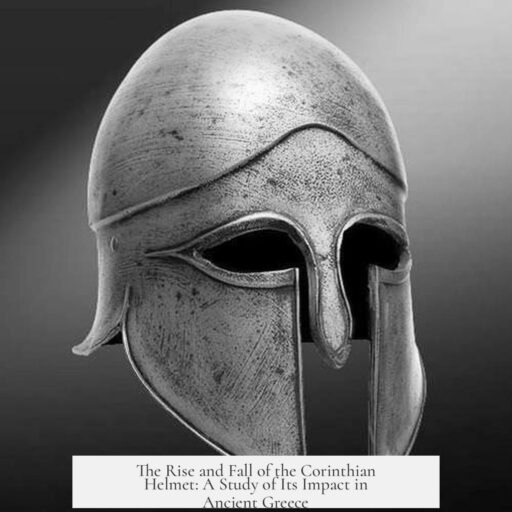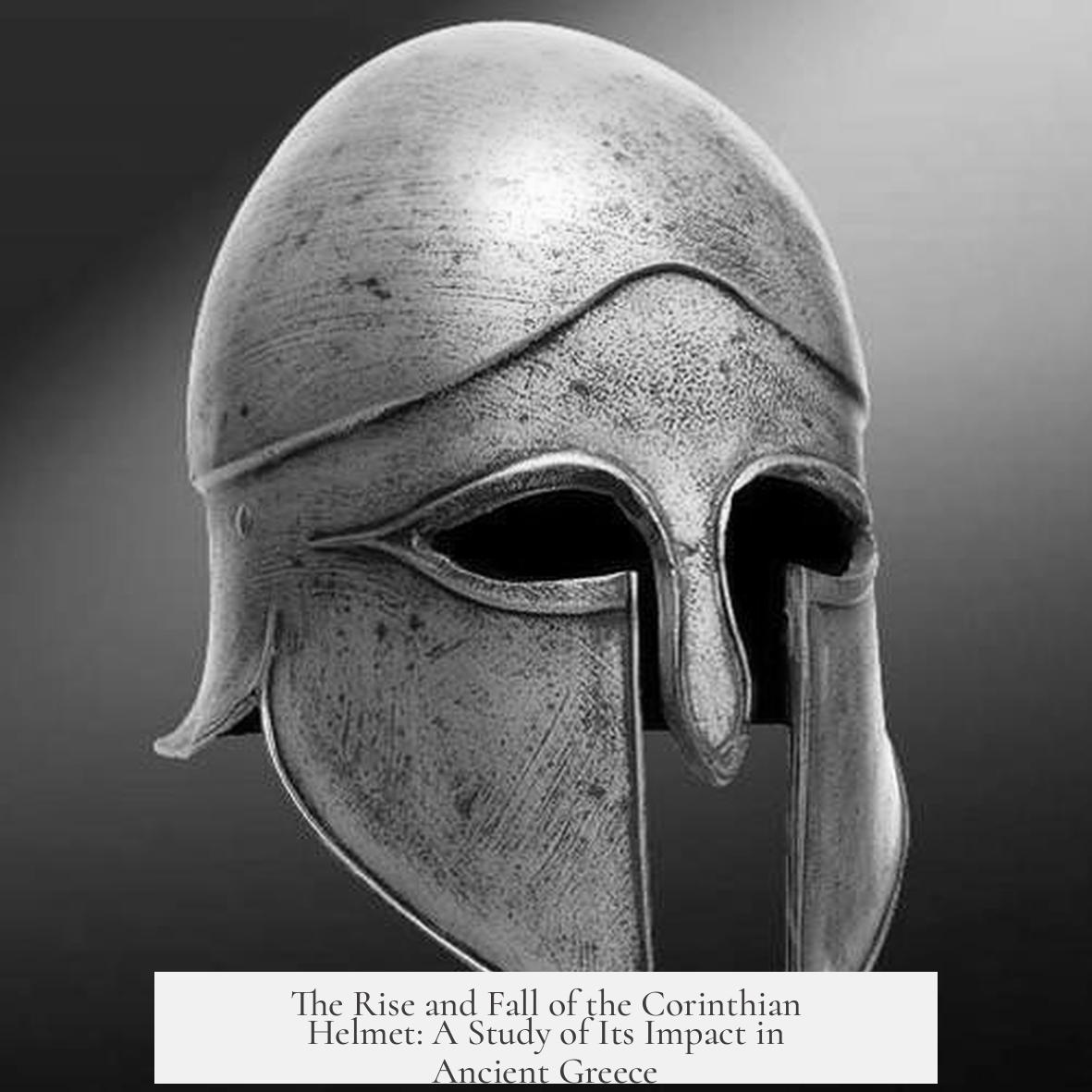The Corinthian helmet is a type of ancient Greek helmet that first emerges at the end of the eighth century BC. It is known for enclosing the entire head and face, leaving only narrow slits for the eyes and mouth. Made from a single sheet of bronze, it became the most popular Greek helmet throughout the Archaic period (approximately 800 to 500 BC), deeply associated with hoplite warriors and their panoply.
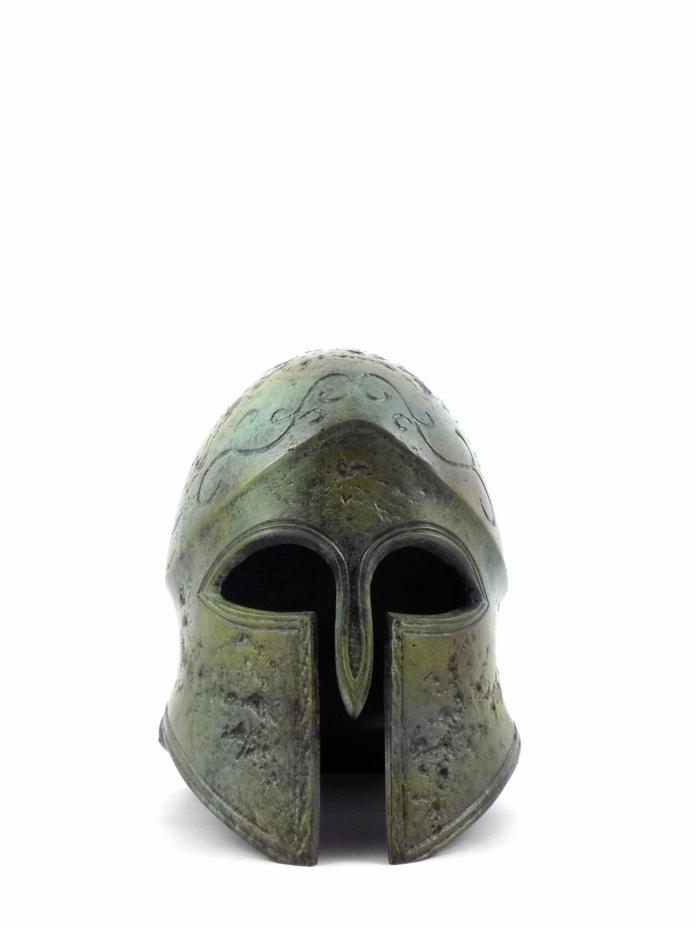
The helmet’s earliest depictions appear in vase-painting, particularly in Corinthian pottery, such as the famous Chigi Vase from the seventh century BC. The design is characterized by a full bronze shell that covers the head completely, offering excellent protection but limited sensory input.
During the Archaic period, the Corinthian helmet enjoyed widespread use. Many examples have been found dedicated at the Panhellenic sanctuary of Olympia, highlighting its cultural and religious significance. Over time, craftwork on these helmets became more elaborate. Late Archaic helmets often featured ridges along the skull and raised lines symbolizing eyebrows above the eye slits. A well-preserved example housed at the Staatliche Antikensammlungen in Munich shows these decorative features clearly.
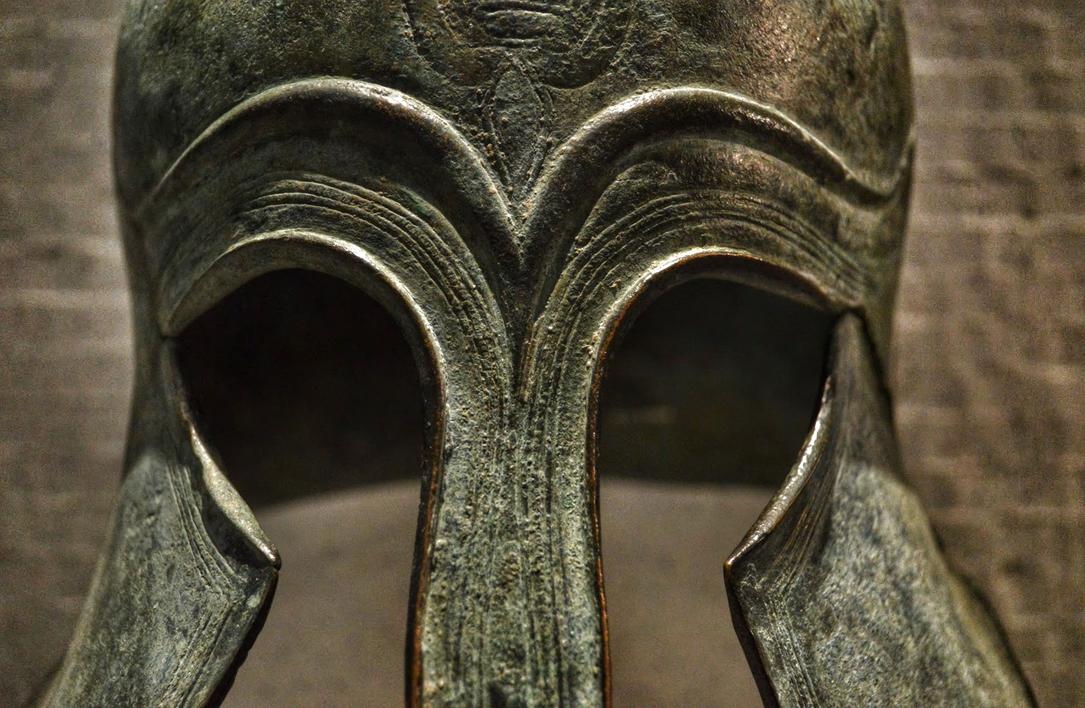
However, by the mid-fifth century BC, the popularity of the Corinthian helmet declined significantly. Archaeological finds, vase depictions, and reliefs indicate that Greek warriors shifted towards helmets that allowed greater exposure of the face and head. The simpler pilos helmet, a type of conical cap, became predominant. This transition indicates a shift in battlefield priorities toward improved hearing and visibility.
Despite this decline in Greece, the Corinthian helmet did not vanish entirely. It continued to appear in artistic representations into the fourth century BC. In Italy, helmets inspired by the Corinthian style persisted much longer, though they evolved extensively. These “Italo-Corinthian” helmets sat atop the head rather than enclosing it. They had large, non-functional eye holes, suggesting a more symbolic or ceremonial use instead of practical battlefield function. These helmets demonstrate how design adapted differently outside Greece.
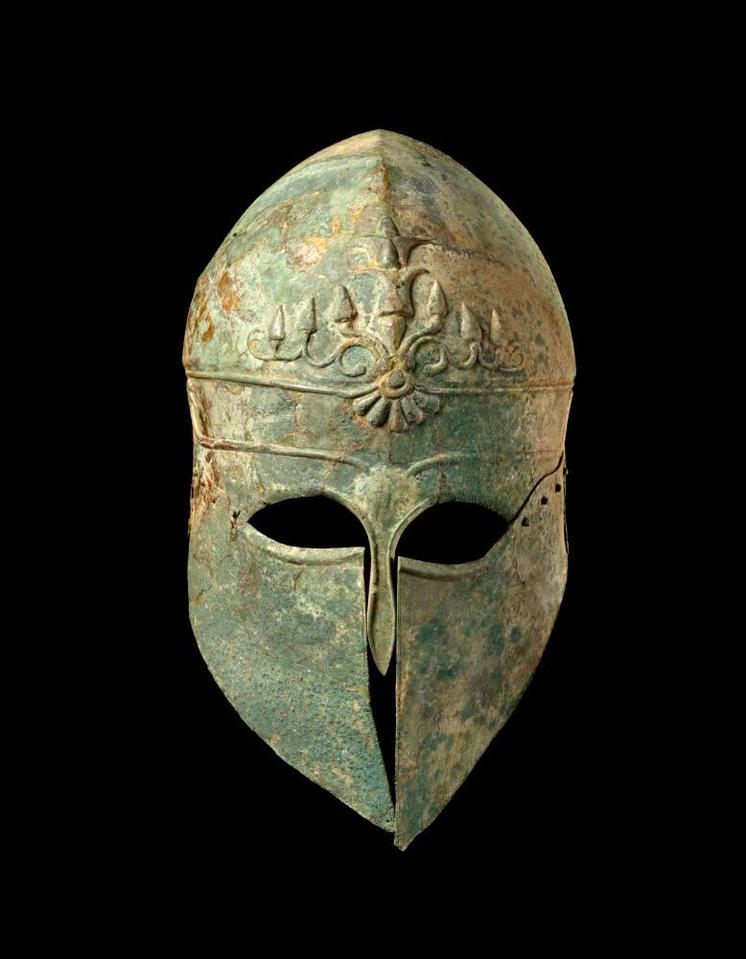
The disappearance of the Corinthian helmet from active military use aligns with larger changes in Greek warfare. As fighting tactics evolved, notably with the adoption of the phalanx formation in the late sixth century BC, the demands on armor shifted. The very protective but restrictive Corinthian helmet compromised sensory awareness, particularly hearing. Later versions of the helmet even left ears exposed, likely reflecting soldiers’ need to hear commands clearly in tightly packed formations.
The phalanx required coordination and communication, which may have driven the preference for helmets that left more of the face and head free. The move towards lighter armor systems and more open helmet designs reflects this tactical innovation. By around 450 BC, Corinthian helmets had been largely replaced by helmets that balanced protection with sensory function.
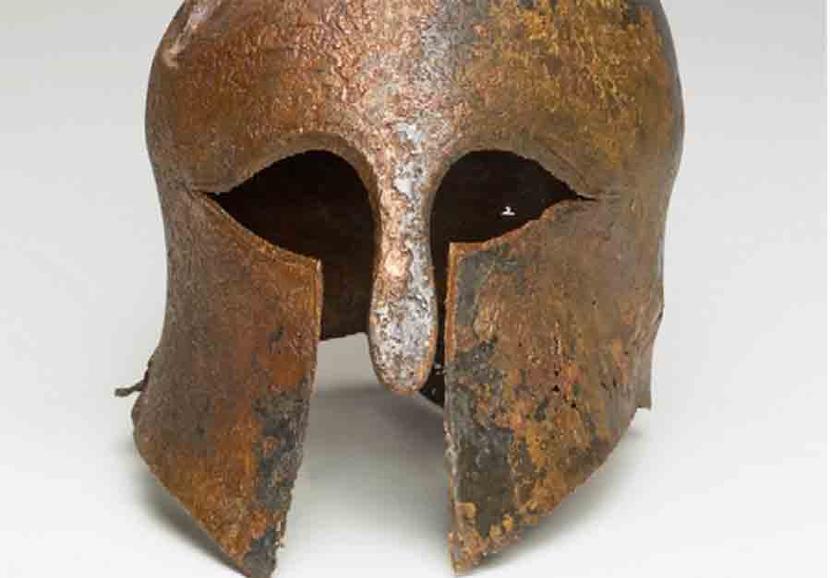
| Feature | Corinthian Helmet | Later Greek Helmets (e.g., Pilos) |
|---|---|---|
| Material | Single sheet of bronze | Bronze or leather |
| Coverage | Entire head and face | Top and back of head, face mostly exposed |
| Visibility | Limited slit-eye holes | Open face, wider field of vision |
| Hearing | Restricted | Improved |
| Use | 8th–5th century BC, ceremonial afterward | Mid-5th century BC onward, battlefield preferred |
The Corinthian helmet symbolizes the early Greek warrior ideal but serves as a case study on how practical needs can drive military technology. Its comprehensive protection was a strength and a weakness. When Greek tactics and battlefield needs evolved, so did helmet designs—prioritizing situational awareness and communication.
- Originated in late 8th century BC, known from Corinthian pottery.
- Made from a single bronze sheet enclosing the entire face.
- Most popular helmet during the Archaic period (800–500 BC).
- Declined in mid-5th century BC as battle tactics changed.
- Replaced by simpler, more open helmets like the pilos.
- Continued in Italy as “Italo-Corinthian” form, more symbolic than practical.
- Decline linked to tactical needs for hearing and vision in phalanx warfare.
The Corinthian Helmet: A Bronze Marvel of Ancient Greece
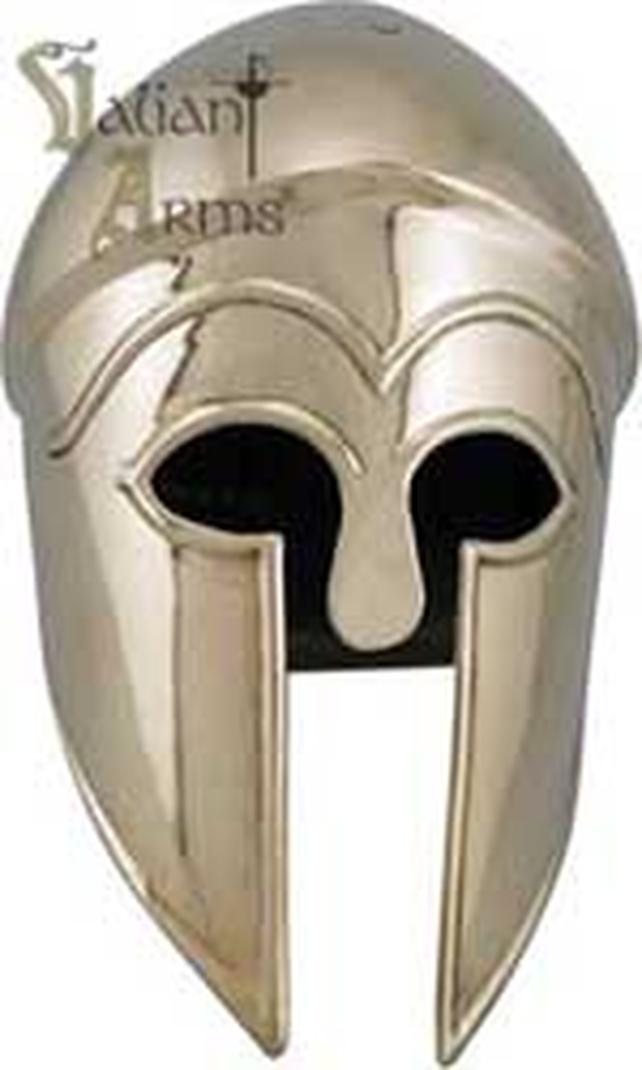
The Corinthian helmet is a bronze headgear masterpiece that fully encloses the face and head, showing only narrow eye and mouth slits. If you imagined it as a snazzy ancient Greek warrior’s crown, you’re spot on. Yet, there’s a twist—the name might be misleading as it may not have originated in Corinth after all.
Let’s dive into its fascinating origin and transformation through history, unraveling why it rose to fame, why it eventually lost favor, and how its legacy stretched beyond Greece.
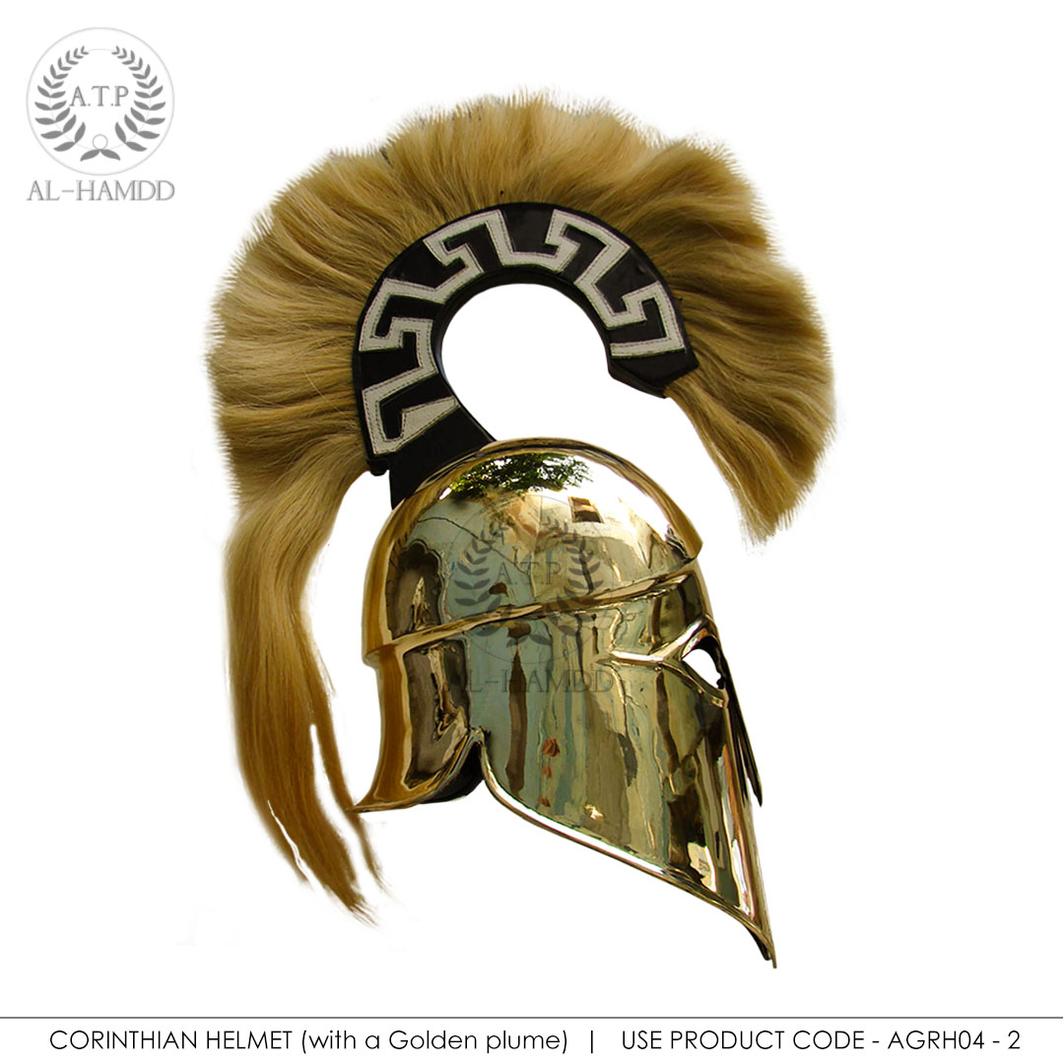
Where did the Corinthian helmet come from?
The earliest evidence of the Corinthian helmet dates back to the late eighth century BC. We first see it in vase paintings, specifically Attic Late Geometric and Corinthian pottery.
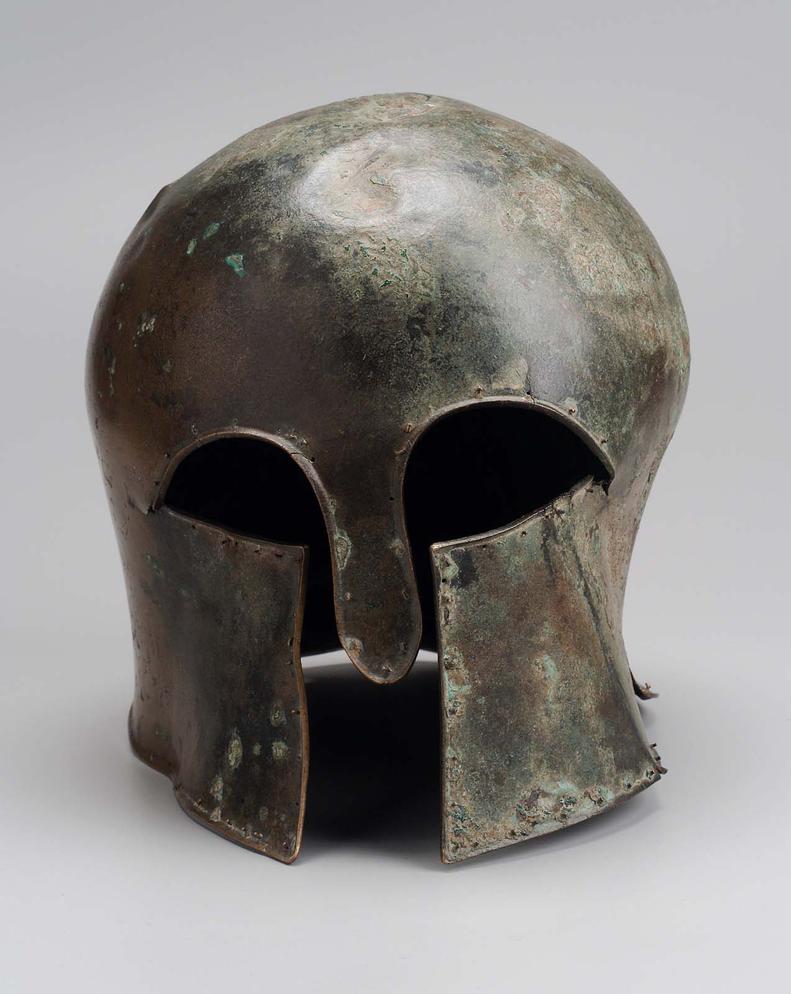
The Chigi Vase, a famous seventh-century BC artifact, beautifully showcases the helmet. Crafted from a single sheet of bronze, it covers the entire head and face, offering solid protection but also creating a distinctive, somewhat intimidating look.
Why was it so popular during the Archaic period?
Between roughly 800 and 500 BC, the Corinthian helmet dominated Greek battlefields. It became the go-to helmet for warriors, highlighted by numerous finds at Olympia, a Panhellenic sanctuary where helmets were dedicated to gods. This wasn’t just armor; it was almost a symbol of honor and divine favor.
Over time, helmets grew more elaborate. Some featured ridges along the skull’s line and relief lines that mimicked eyebrows above the eye holes. An exquisite example from Munich illustrates this evolution clearly, blending artistry with battlefield practicality.
The decline: Why did the Corinthian helmet fall out of use?
By the mid-fifth century BC, something changed. Warriors started ditching this fully enclosed style for simpler helmets that left more head exposed. Pretty curious, right? Instead of clunky bronze cages, helmets like the pilos became popular. The pilos—a conical cap—offered better hearing and visibility. It was a welcome upgrade to the battlefield headset.
Interestingly, it wasn’t just the helmet. Armor overall slimmed down. In the mid- to late sixth century BC, warriors sported loads of bronze armor—from bell-shaped cuirasses to thigh guards. A century later, it was mostly tunics, shields, and helmets, nothing heavy. Maybe Greek soldiers wanted to stay quick on their feet and not sound like pots clanging in a fierce wind.
Did the Corinthian helmet vanish completely?
Not quite! After 450 BC, this helmet became rare but didn’t totally disappear. Greek art displays it sporadically into the fourth century BC. Meanwhile, across the sea in Italy, helmets inspired by the Corinthian design lingered much longer. But these were strange relatives.
While Greeks pushed the helmet down over the face, Italians wore theirs perched on top of the head, eyes peeking from seemingly useless holes. It’s like a fashion statement rather than protective gear. Anthony Snodgrass calls this the “grievously distorted form” of Corinthian helmets. This odd evolution shows cultural twists in how ancient peoples viewed war gear.
So, why did it disappear from the Greek battlefield?
One practical reason stands out: hearing. Late Corinthian helmets often left ears exposed, hinting that soldiers needed better auditory awareness. Listening to commands or spotting an ambush means more than looking intimidating.
Plus, military gear generally got lighter and less restrictive. The Corinthian helmet’s full-face bronze shell probably felt like wearing a medieval pot on your head when quick reflexes and communication mattered more in evolving warfare.
The phalanx formation and its impact on helmet use
Could changes in battlefield tactics explain the helmet’s fate? Absolutely. The phalanx formation, associated with Greek warfare, reshaped how soldiers armored themselves.
The phalanx, contrary to some beliefs, didn’t emerge as early as 700 BC but appeared later, in the latter part of the sixth century BC. As this tight, shielded formation developed, there were four significant changes in warfare correlating with helmet evolution. One key shift was the need for better communication among soldiers packed shoulder-to-shoulder.
Having a helmet that muffled sound or limited vision became a liability. Consequently, open helmets that allowed more sensory input made more sense. It neatly explains why by around 450 BC, the Corinthian helmet, with its bronze enclosure, faded.
Lessons and reflections from the Corinthian helmet saga
The Corinthian helmet is a stellar illustration of ancient innovation meeting practical needs. It started as a design marvel that gave warriors full protection and an almost fearsome visage.
Yet, as combat strategies evolved and sensory awareness gained importance, the design lost ground to lighter, more functional headgear. This story reveals how technology and tactics shape gear, echoing even in today’s military equipment.
Does the story remind you of any modern gear adaptations? Perhaps helmets for cyclists or firefighters who balance protection with awareness? The past thoughtfully informs the present.
Summing it up
The Corinthian helmet holds a unique place in ancient Greek warfare, art, and culture. Its rise, embellishment, and eventual decline showcase an intriguing interplay of craftsmanship, military tactics, and human needs on the battlefield.
While it might not have originated in Corinth strictly, this helmet’s iconic design lives on in museums and art, reminding us how practical design can also be a statement of identity and power.
So next time you see a movie with an ancient Greek soldier, check if he’s rocking the Corinthian helmet—you’re looking at a piece of history that once defined how Greeks fought, protected, and saw themselves.
What made the Corinthian helmet distinctive compared to other Greek helmets?
The Corinthian helmet was made from a single bronze sheet. It covered the entire head and face, leaving just eye and mouth slits. This full coverage was unique among Greek helmets of its time.
Why did the Corinthian helmet fall out of use around 450 BC?
Warriors began favoring helmets that exposed more of the head and face to improve hearing and comfort. The simpler pilos helmet, a conical cap, became popular, replacing the heavier, enclosing Corinthian helmet.
How did the Corinthian helmet influence helmet designs in ancient Italy?
Italian helmet designs derived from the Corinthian helmet but were worn differently. They sat atop the head with eye holes that were often non-functional, showing a distinct style separate from the original Greek use.
Did changes in Greek warfare affect the design and use of the Corinthian helmet?
Yes. As the phalanx formation became common in the late sixth century BC, helmets that allowed better hearing and visibility became essential. This shift reduced the Corinthian helmet’s battlefield role.
Were Corinthian helmets ever used after the Archaic period?
They rarely appeared in battle after 450 BC. However, they lingered longer in art until the fourth century BC. In Italy, helmets inspired by the Corinthian style continued but in modified forms.
